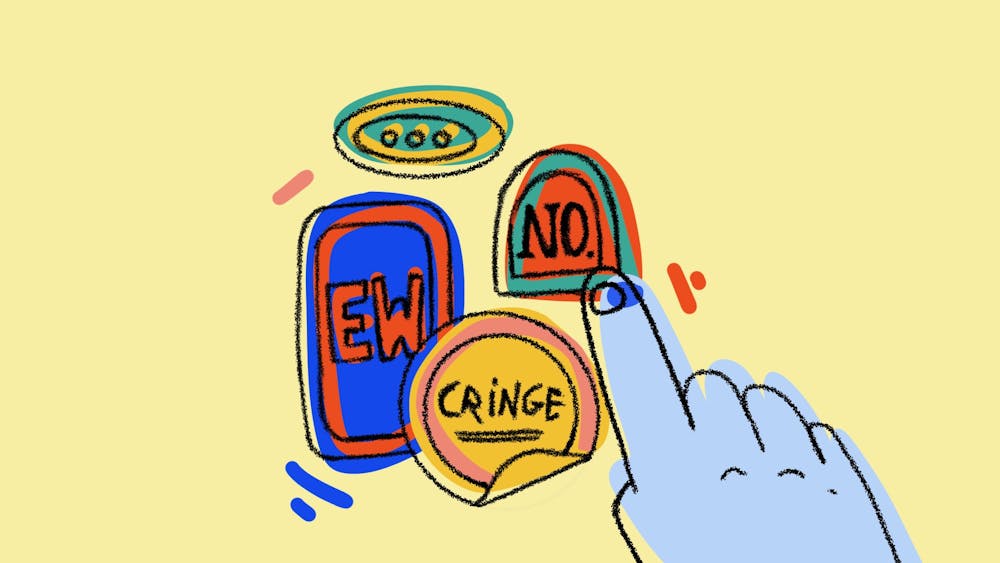About a month ago, creators took to TikTok to parody a video of a couple, Lilianna Wilde and Sean Kolar, demonstrating what they called a “love surge.” In this video, which opened with Wilde asking viewers if they “wanna see the cringiest most coupley thing ever,” she animatedly explained that a love surge happens when the couple has “so much love in our limbs that we can’t contain it and feel like we’re gonna explode.” Meanwhile, Kolar stood behind her, shaking and bouncing up and down. When she gave him the cue, telling the audience that “he’s gonna wrap around me and shake with the electricity of love,” Kolar did just that: he, wearing a large grin and letting out a breath, hugged her, sharing the shaking sensation with his girlfriend. They then “explode with a love surge,” in which they both reach up, as if in a stretch.
Admittedly, this video is “cringe” for multiple reasons. First, people don’t expect to see such displays of affection in such an outwardly public manner, even with the lack of any inherently promiscuous content in the video. Second, people tend to perceive body language shown in the video as abnormal, and thus worthy of judgment. Lastly, the nature of the women’s speech—over emphasized and over–enunciated—feels as if she is talking to a kindergartener.
To this nature, comments were extremely critical, such as “I need a love surge protector” or “I have seen this against my will.” Yet, these negative comments were interspersed with the occasional “I love cringey cute love” or “I dunno why people are hating, this is cute.” There are currently 426 posts under this sound, the vast majority of which are parodies or “reaction” videos, which demonstrate the extremely negative light in which this video was received.
One video stitched this clip to talk about the notion of the “cringe.” Creator Therapy by Tracy describes the response to this video as one “designed to distance yourself from other people, because there’s a part of you that understands [the couple’s behavior].” She explains that perhaps “there was a time in your life when you were a silly goose.” She then claims that you want to be like them, but you just can’t, because society told you to “be like everybody else.” Although this claim is a bold one, the idea that we have lost some of the childhood joys in adulthood feels very topical.
Sure, we can say that some of the judgment towards this couple is warranted. But perhaps some of it is a projection of the loss of our childhood: We are constantly under surveillance by our peers and accordingly subscribe to what is considered “normal” and what is “cringe.” Acting outside of this perceived normalness leads to harsh judgment, like that which is imparted onto this couple. That is, we seem to have a certain childhood that we have lost in order to fit into society. Tracy believes that calling things cringe is a projection of our disdain for our own inner child.
Perhaps, then, this shame is related to the loss of the adolescent stage in our youth. Namely, within the recent phenomenon of our children losing their pre–teen years and jumping straight to what society might refer to as the teenage stage lies in the marketability of shame through platforms such as TikTok or Instagram.
A certain genre of TikTok video is produced by an older Gen Z or Millennial creator. They stitch a video made by a young middle schooler participating in trends and dances, usually wearing makeup and clothing that might be considered “mature” for their age. They are, in a word, pretty, and utterly unlike the braces and side–part–filled pre–teen selfies of a slightly older generation. The video then cuts to a clip of the older creator when they were in middle school taking part in an activity we might consider “childlike,” whether that be recreating a music video with low production value or performing for their family. To put it bluntly, many of today’s pre–teens act like teens. So where did that awkward middle school phase, that we lovingly call adolescence, go?
This progression towards the abolishment of adolescent years—intentional or not—may be because middle schoolers, who are now more online than ever, have access to videos that get hate comments such as the love surge video or other “cringe” compilations. While we watched America’s Funniest Home Videos, these middle schoolers watch—and judge—TikToks.
Through this exposure to online judging, children are picking up on societal norms—the same norms that create a culture of shame and same–ness. When children have an online, front–row view to this shame, they begin to reject their inner child even before they have grown out of childhood. It’s easy to make fun of cringey videos, but maybe we should renounce those pressures and the resulting urge to shame others for just being themselves.







